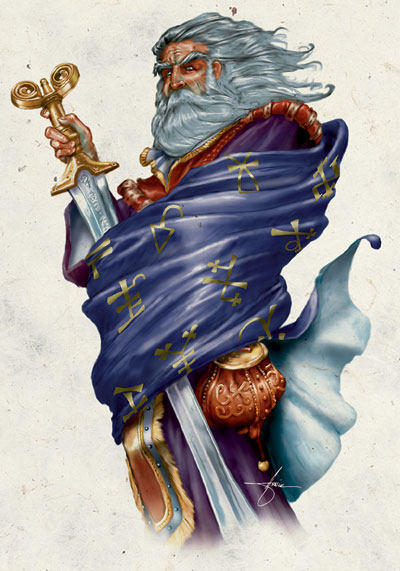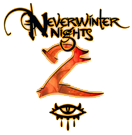Shaundakal

| |
| Shaundakul | |
|---|---|
| Titles | The Helping Hand, Ride of the Winds |
| Symbol | A wind-walking bearded man in traveler's cape and boots |
| Home Plane | Gates of the Moon |
| Alignment | Chaotic Neutral |
| Portfolio | Caravans, explorations, miners, portals, travel |
| Worshipers | Caravaneers, explorers, half-elves, rangers, and portal-walkers |
| Domains | Air, Chaos, Portal, Protection, Trade, Travel |
| Favored Weapon | Greatsword |

|
Neverwinter Nights 2 Wiki Visit related material |

|
Forgotten Realms Wiki Visit related material. |
Shaundakul (pronounced SHAWN-da-kul), the Rider of the Winds, is the Faerûnian lesser deity of traveling and travelers, exploration, caravans, the wind, and mining and miners. Recently, Lord Ao gifted him with the portfolio of portals and portal-walking. He manifests bodily as a bearded man who wears a traveler's cape and is armed with a greatsword called the Sword of Shadows.
Dogma
Spread the teachings of the Helping Hand by example. Work to promote him among traders, especially trailblazers who seek out new lands and new opportunities. Unearth and resanctify ancient shrines of Shaundakul. Ride the wind, and let it take you wherever it blows. Aid those in need, and trust in the Helping Hand. Seek out the riches of the earth and sea. Journey to distant horizons. Be the first to see the rising sun, the mountain peaks, the lush valleys. Let your footsteps fall where none have tread.
Clergy and Temples
Members of the clergy are expected to live off the land and work as guides and protectors of travelers, caravans, and mining expeditions. Many serve as guides for adventuring companies or as explorers. A very few are Harpers. All seek to visit the scattered shrines of Shaundakul (particularly the great one in Myth Drannor) as frequently as possible and to construct new ones when they acquire sufficient resources. Ever since Shaundakul added portals to his portfolio, his clerics have been tasked with locating and identifying portals that would be useful for trade and exploration.
Shaundakul prefers to be venerated at shrines, most of which are uninhabited and in remote places. Typically, a shrine to Shaundakul is a stone dais built atop a high place, crowned with a stone seat or throne, and accompanied by one or more stone pillars pierced with holes through which the wind whistles. Many such shrines exist throughout the Moonsea and the Stonelands, some of them over a thousand years old. Shaundakul is not commonly worshiped within cities and he has few formal temples as a result. Because the clergy members love to wander, his few temples constantly have new clerics arrive as others leave.
Shaundakul's clerics wear a dark swirling cloak over garb appropriate for the trail, and favor dark colors and silver in general. Many wear their holy symbol on the back of their gauntlet (usually leather or chain mail).
Shaundakul's church is loosely organized, and its branches are largely independent. There is little in the way of formal hierarchy, although those who served the Rider of the Winds prior to the Godswar hold positions of great respect in the church. Since the Time of Troubles, several military orders have been founded in the name of Shaundakul. The Fellowship of the Next Mountain is an order of rangers and clerics who typically work alone, blazing trails in the uncharted wilderness areas of the Sword Coast North and Moonsea North. The Knights of the Shadow Sword are an elite order of fighters and rangers based in Shaundakul's Throne and dedicated to cleansing Myth Drannor of the evil that haunts its streets and ruins. Initially, they are fortifying the ancient Myth Drannan temple as a base of operations and sending out scouts to reconnoiter the ruined city. The Riders of the West Wind are an order of clerics and a few rangers who hire themselves out as a mercenary company to guard caravans heading through uncharted wilderness to distant lands.
Their holy day is the Windride, which is celebrated on the 15th day of Tarsakh. On this day, Shaundakul causes all his clerics to assume gaseous form at dawn, if they cannot wind walk on their own, so that they are carried with the wind. They return to normal (and are lowered safely to the ground) at dusk, usually in some place they have never been before.
| Deities | |
|---|---|
| Overgods | |
| Major | |
| Minor | |
| Drow | |
| Dwarven | |
| Elven | |
| Gnomish | |
| Halfling | |
| Mulhorandi | |
| Orcish | |